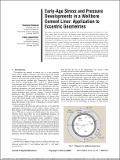Early-Age Stress and Pressure Developments in a Wellbore Cement Liner: Application to Eccentric Geometries
Author(s)
Petersen, Thomas; Ulm, Franz-Josef
DownloadUlm_Early-age stress.pdf (1.857Mb)
PUBLISHER_POLICY
Publisher Policy
Article is made available in accordance with the publisher's policy and may be subject to US copyright law. Please refer to the publisher's site for terms of use.
Terms of use
Metadata
Show full item recordAbstract
his paper introduces a predictive model for the stress and pressure evolutions in a wellbore cement liner at early ages. A pressure state equation is derived that observes the coupling of the elastic changes of the solid matrix, the eigenstress developments in the solid and porespaces, and the mass consumption of water in course of the reaction. Here, the transient constitution of the solid volume necessitates advancing the mechanical state of the poroelastic cement skeleton incrementally and at constant hydration degree. Next, analytic function theory is employed to assess the localization of stresses along the steel–cement (SC) and rock–cement (RC) interfaces by placing the casing eccentrically with respect to the wellbore hole. Though the energy release rate due to complete debonding of either interface is only marginally influenced by the eccentricity, the risk of evolving a microcrack along the thick portion of the sheath is substantially increased. Additionally, it is observed that the risk of microannulus formation is principally affected by the pressure rebound, which is engendered by the slowing reaction rate and amplified for rock boundaries with low permeability.
Date issued
2016-07Department
Massachusetts Institute of Technology. Department of Civil and Environmental EngineeringJournal
Journal of Applied Mechanics
Publisher
ASME International
Citation
Petersen, Thomas, and Franz-Josef Ulm. “Early-Age Stress and Pressure Developments in a Wellbore Cement Liner: Application to Eccentric Geometries.” Journal of Applied Mechanics 83.9 (2016): 091012. © 2016 by ASME
Version: Final published version
ISSN
0021-8936
1528-9036